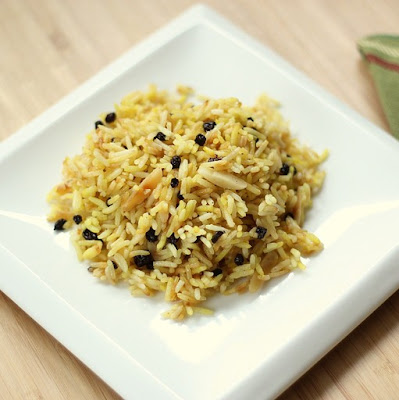Originally published March 13, 2012
I’ve mentioned many times before that my friend, Hedy (who is Persian) is a fantastic cook. And that Mr. Eats never turns down an invitation to dinner at her house because there will always be a spectacular meal.
Barberries, cranberries, and sour cherries also work and are a bit prettier than currants.[/caption]
Not long after I started my blog, I posted her recipe for baghali polo (or baghali polow) . With the exception of the dill and fava beans, it’s actually a good tutorial for making any type of Persian rice (polow), including basic saffron rice (adas polow). [If you're looking for a bit more detail (and some yogurt), this post also has a really good step-by-step tutorial for standard Persian rice.] When you prepare the rice this way, you get a wonderful crunchy layer of rice on the bottom of the pot (tahdig). And you can add whatever bean, dried fruit, nut, and/or herb to make it different. One really nice combination she made had toasted slivered almonds and barberries.
You should really crush your saffron before trying to dissolve it. Oopsie.[/caption]
The rice is wonderful, rich and flavorful, but the star of the show is the tahdig. It is so delicious. Some cooks will use a wider pot to maximize the size of the tahdig and minimize the fighting over it.
But it can take a while to get a proper tahdig. And when I made this Persian rice, I was in a bit of a time crunch, so I adapted a recipe to get a good pilaf in about 25 minutes. It’s really tasty (made more decadent by the butter), but I think Mr. Eats was disappointed by the lack of tahdig. Regardless, this makes a wonderful side dish. You can subsitute more olive oil for the butter if you do not eat butter. But the butter browns a bit, adding a more robust flavor to this shortcut.
Yum![/caption]
Notes: You really have to use basmati rice for this dish to turn out just right. It's a long, slender grain which has a different "mouthfeel" from standard long-grain rice. Also, it's important not to overcook it in the first step so that you don't get sticky, gooey rice. What's great about this rice is how the individual grains stay separated. Also, I've never had this rice without saffron, but I think it would be nearly as delicious without if if you don't have any on hand.
Persian Rice Pilaf with Almonds and Currants
adapted from Food and Wine
serves 4-62 cups white basmati rice
4 cups water
1 teaspoon salt
½ cup slivered almonds
4 tablespoons butter
4 tablespoons olive oil
2 tablespoons sugar
½ cup dried currants (or cherries, golden raisins, or barberries)
¼ to ½ teaspoon crushed saffron threads
1 tablespoon water
additional salt and pepper to tasteBring the four cups of water to a boil in a large saucepan. Add salt and rice, lower the heat and simmer for 5- 10 minutes. Do not overcook. Rice should be slightly “al dente.” Drain the rice thoroughly and return to the sauce pan. Set aside.
Dissolve the saffron in the one tablespoon of water and stir into the rice.
Pre-heat the oven to 400F.
Brown the almonds over medium-high heat in a medium or large skillet. Stir frequently to prevent scorching. When browned, pour the almonds in a bowl and set aside.
In the same skillet, reduce the heat to medium and add the butter and oil. Then add the currants and sugar. Cook until the sugar has dissolved and the butter has browned a bit, stirring frequently (just a few minutes). Remove from the burner and set aside.
Spread half the rice in a casserole dish or other baking dish (at least 3 quarts). Pour half the butter mixture over the rice and sprinkle with half the almonds. Then spread the remaining half of the rice in another layer and pour over the remaining butter mixture and almonds.
Cover (with lid or aluminum foil) and bake for 15-20 minutes or until the rice is soft and there's some browning around the edges. Season with salt and pepper to taste when serving.



No comments:
Post a Comment